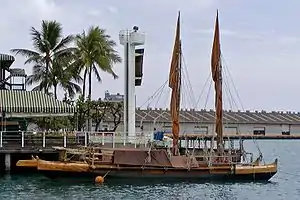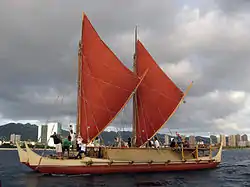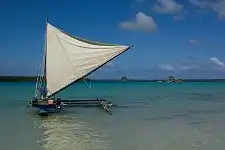Hawaiʻiloa
Hawaiʻiloa is the settler of the island of Hawai'i based on an ancient Hawaiian legend.[1]
Legendary navigator
According to the legend, Hawaiʻiloa was an expert fisherman and navigator. While out with a crew of men, they accidentally stumbled upon the island of Hawaiʻi which was named in Hawaiʻiloa's honor. Hawaiʻiloa returned to his homeland of Ka ʻāina kai melemele a Kane, "the land of the yellow sea of Kane" in order to bring his family back with him to Hawai'i. He then organized a colonizing expedition with his family and eight other skilled navigators. They settled on what is now the Island of Hawaiʻi, named in his honor.[2]
The legend contains reference to his children: Maui (eldest son), Kauaʻi (son), and Oʻahu (daughter) who settled on the islands that bear their names.
The story of Hawaiʻiloa has received a great deal of attention from modern Hawaiians, as a realistic depiction of the settling of the islands, consistent with current anthropological and historical beliefs. Many people believe it is a validation of the veracity of ancient Hawaiian oral traditions.
However, the story of Hawaiʻiloa is attested only by late sources, such as the antiquarians Abraham Fornander and Thomas George Thrum. As they did not give their original Hawaiian sources, but only digests and compilations, we cannot be sure that the tale has not been slanted towards proof of Fornander's now discredited migration theories, or that it has not been elaborated by 19th century Hawaiians eager to stress the validity of their own beliefs.
Hawaiʻiloa is not mentioned in early Hawaiian historian sources like David Malo or Samuel Kamakau. Malo says there are many stories about the origin of the Hawaiians and cites some migration tales and some legends of indigenous origin. He does not mention Hawaiʻiloa. Kamakau says that the first man and woman were Hulihonua and Keakahuilani, and that they were created on Oʻahu.
Canoe

Hawaiʻiloa is also the name of a voyaging canoe, built between 1991 and 1994.[3] Named after the legendary navigator, the canoe was built for ocean navigation and has sailed internationally. The canoe Hawaiʻiloa is now docked at Honolulu Harbor. It is often sailed on long voyages throughout the Pacific Ocean, studying voyaging techniques used in Ancient Hawaii.
Building
To make the canoe, two Sitka spruce logs were brought to Hawai'i from Southeast Alaska, donated by the SeAlaska Corporation (owned by the Tlingit, Haida, and Tshimshian tribes). These came from 400-year-old, 200 feet high trees, a size which could not be found in modern Hawai'i. The hulls of the canoe were designed by Rudy and Barry Choy and Dick Rhodes, and also used numerous woods from more local sources.[3] The canoe was made without metal parts, and used three miles of lashing.[4]
Hawaiʻiloa is 57 feet long, and with a beam of 19 feet. She has two sails, each of 240-420 sq. feet. She was initially launched in July 1993, and subsequently modified in dry dock before being re-launched a year later.[3]
Voyages in 1995
In 1995 Hawaiʻiloa sailed her maiden voyage to Tahiti, Ra`iatea and Nuku Hiva in the Marquesas Islands[5] in company with Hokule'a and a third canoe from Hawai'i called Makali'i together with two canoes from Rarotonga: Te 'Au Tonga and Takitumu, and the canoe Te 'Aurere, from New Zealand. Subsequently that year, Hawai'iloa was shipped to Seattle and then sailed north to Alaska, visiting twenty native villages on the coastal journey between Vancouver and Juneau.[4]
See also
References
- Samuel M. Kamakau and Z. Kepelino: Hawai‘iloa and the Discovery of Hawai‘i www2.hawaii.edu, accessed 25 September 2020
- "Origins of Hawaii's Names". Archived from the original on 2006-12-30. Retrieved 2007-02-24.
- The Building of Hawai‘iloa archive.hokulea.com, accessed 2020-09-22
- Nainoa Thompson: Recollections of the Building of Hawai‘iloa and the 1995 Voyages archive.hokulea.com, accessed 25 September 2020
- Nainoa Thompson - Biography www.ifa.hawaii.edu, accessed 25 September 2020



.jpg.webp)